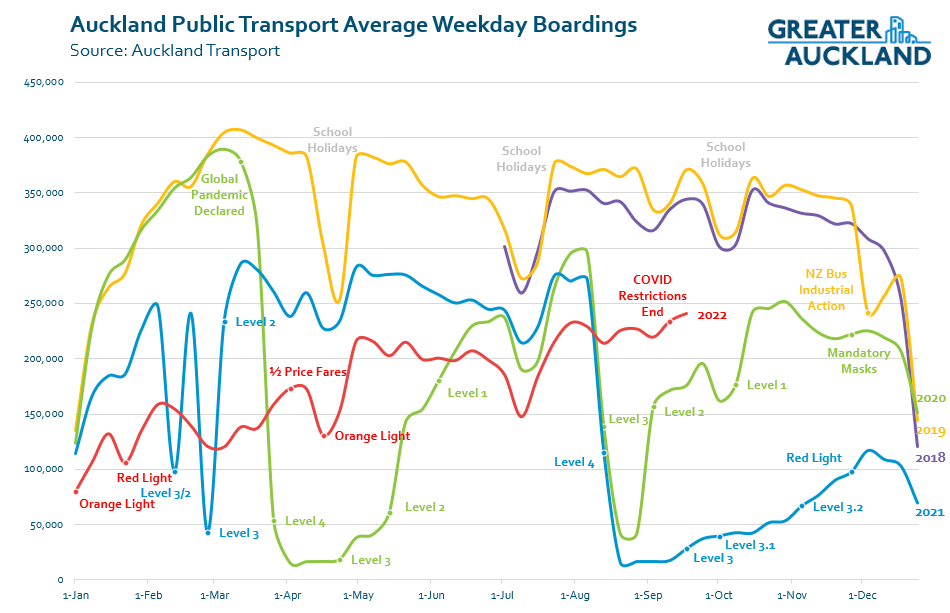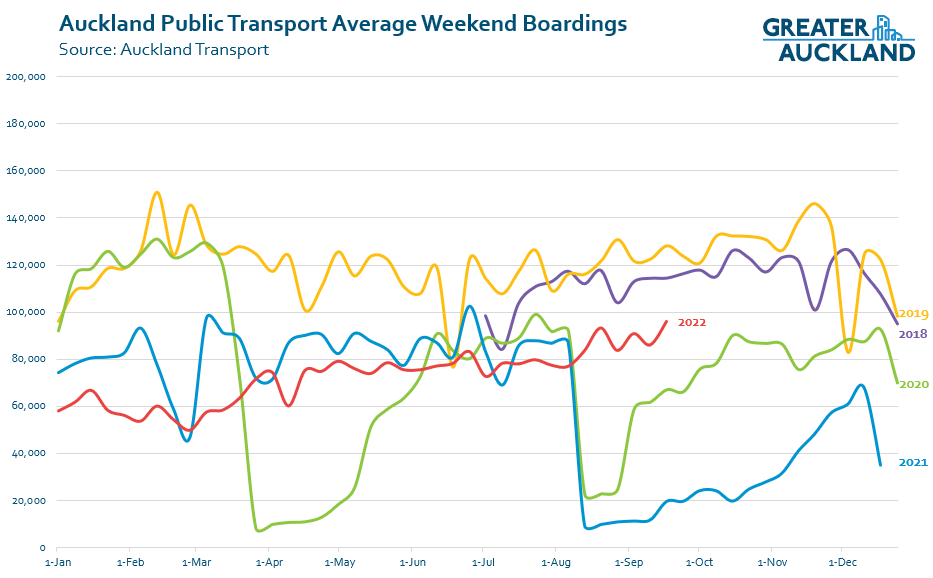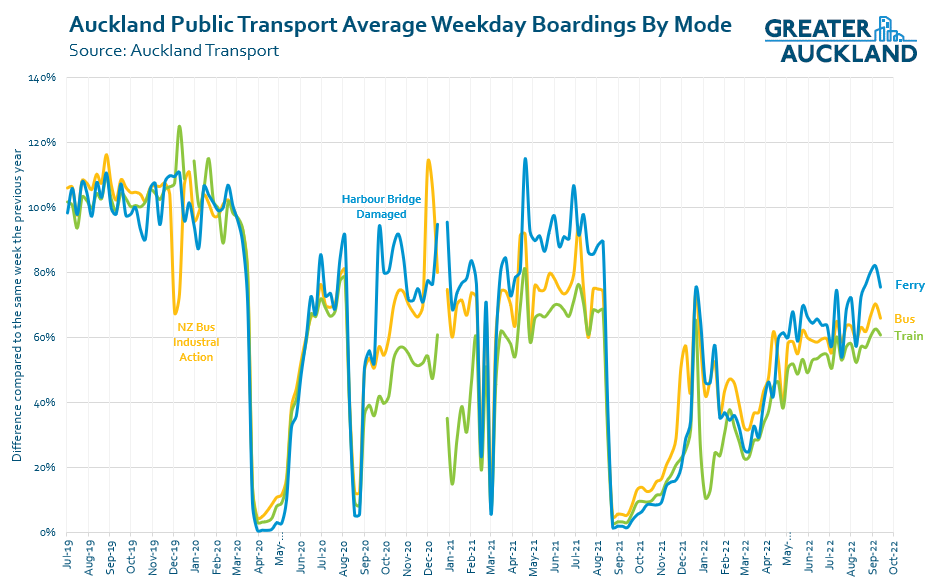With COVID restrictions mostly removed and other winter illnesses receding, I’ve been back in the office more regularly. But I’m clearly not the only one and particularly over the last few weeks trains and buses have been feeling much busier with some trips even feeling a bit more like the before times. And those anecdotal observations are starting to be backed up by the data.
Auckland Transport’s data shows that last week was the busiest on public transport this year with the weekday average passing 240k trips per day for the first time since delta struck in mid-August 2021. Last week also saw the first day with more than 250k trips too. That’s good news and with the last few weeks sitting at around 65-70% of pre-COVID levels, it suggests PT use is finally starting to recover again after being stuck in the 55-60% range during autumn and winter.

As you can see above, we still have some way to go, even compared to other times since the initial lockdown in 2020 when we reached 270-300k before new lockdowns occurred.
The results are actually slightly better on weekends with usage last week close to 100k per day, or about 75% of pre-COVID levels.

Given the anecdotal observations around some buses and trains being quite full again, I do wonder if one thing we’re seeing is that demand on the edges of the peak times is not as strong.
Looking at the results by mode we can see that trains continue to lag behind buses and ferries and this has been the case since August 2020, when after seeing usage recover at a similar rate to buses, the large rail network shutdowns began after it was discovered the network was in much worse shape than expected. However I do expect that train usage might also be being impacted because those services were used by a higher proportion of city office workers who are now working from home more.

Speaking of working from home, Mondays are, perhaps unsurprisingly, the quietest weekday is a Monday. Meanwhile the busiest day is a Wednesday.
One area where the drop in usage, and the more recent half price fares, is having a major impact is in the amount of money collected from fares in comparison to the cost to run the system – a metric known as farebox recovery. The metric has a bit history as the previous National government set an arbitrary target of achieving 50% of costs covered by fare revenue regardless of what the level was that would attract the most economic benefit. Auckland did reach that milestone in mid-2016 before integrated fares and the then new bus network started rolling out.
As usage rose and AT put extra services on to cope with the demand – which was primarily at peak which is the most expensive time of the day to provide, farebox recovery had fallen to about 42%. However, the arrival of COVID has seen reach a new low of just over 14%.

Related to this, the amount of subsidy per passenger km to run services has skyrocketed to an average of $1.42 per km.

Casting our gaze overseas we can see that even some of the cities with rich public transport provision, like London, Barcelona and Madrid, are still only seeing PT use of around 80% compared to pre-COVID levels. You can also see that Wellington is looking strong and in August usage was around 78% of 2019 levels. Given the results we’re started to see in September, it’s possible we could soon be seeing Auckland back to those levels.

Have you been noticing more people on buses, trains and ferries?

 Processing...
Processing...
Yes there are more people on the buses, at least those that run. Some NX1 services have no seats empty leaving Albany for the city in the morning, but that is because 50+% of the services are canceled.
Quite hard to see more people on the bus when they are cancelled. I heard a rumor that bus companies aren’t having to pay penalties for missed services currently, so it is in their financial interest not to get new drivers on board.
I have definitely noticed more people on the trains on the weekends. These days I mostly cycle as I started a new job very close to where I live so no need for me to take the bus that often. But yes, it feels busier which is really great. Having said that Newmarket, which is my most frequent destination, is very busy with cars despite being so well connected with the whole city. There seems to be so much untapped potential there.
Newmarket is a cluster*. Poor planning from every angle you look at it. I avoid it because it’s awful for pedestrians, and just not pleasant.
It takes me almost an hour to travel to Newmarket for work on PT from the North Shore with a trip distance of only 10km! It would only take 25 minutes to drive, and that’s during peak times. No wonder there’s so many cars on the road.
Some through-routing would already help with this. Something Auckland Transport should have learned from running line 881 back in the day. I can drive to Grafton during full morning rush hour, and I will make it faster than with public transport despite spending 45 minutes queueing up on Onewa Road. Any trip across the city centre is so debilitatingly slow there is no point even trying. The problem is that most buses don’t drive across the CBD but terminate just before reaching the centre, so very few of them actually intersect.
Maybe this will improve after Te Wai Horotiu (Aotea) station opens. Not sure what the travel time would be from that station to Newmarket. Assuming that trains will run more frequently than 30 minutes, or what is it now, in the weekend. That should be a safe assumption, there is no point boring a tunnel and then running almost no trains through it.
A one seat ride option is the 866 bus, or use the NX1 and transfer to southern or western train is in theory ~35mins from Sunnynook Bus Station.
A lot more tourists are coming in now which will be helping Auckland PT patronage numbers. The availabity/convenience of getting a HOP card at the airport needs to be improved. I’ve heard the existing retailers are closing at 8 pm so if people arrive after that time they are out of luck. It pushes potential users onto Skydrive or taxis instead of the PT system.
Saw that on Reddit
Panicky person just arrived into the domestic terminal and needed to get on a bus to their destination, so wanted to get a HOP card and the retailer had shut
Seriously needs to be vending machines stocked with pre-paid HOP cards scattered around the airport, ferry terminals, train and bus stations.
(and virtual HOP card on phones, but I won’t push that again)
Melbourn does this well.
Heard AT are putting in a hop vending machine at the airport soon to fix this issue
HOP vending machines are great for top ups or one off paper tickets but normally they don’t sell cards. Just wondering how they will do that unless they are going to put packaged HOP cards in a regular vending machine for sale.
Yes the team in charge of the domestic terminal vending machine trial presented at AT’s weekly internal “All Hands” session. They said it was going to be installed mid to late September. So, any day now…
Simon C – yes that’s exactly right, they will be preloaded AT Hop cards in a vending machine
domestic terminal vending machine trial?
It takes months or years to put a card vending machine in place?
When I could pick up a phone and get a vending machine installer to put one already setup for gift cards next week?
Bus patronage won’t return to anywhere near 2019 levels until they can fill the 500 vacant driver positions and end the cancellation of thousands of services…
I am actually quite surprised that with so many services being cancelled on a daily basis, the patronage keeps growing. We still have got a long way to go but we seem to be getting there. Hopefully, the increased hourly rates will help retain the current drivers and attract new ones.
Do the constant rail bus replacements increase the cost of running the rail network?
Check out San Francisco in the last graph. 2 1/2 years on and still below 50%. It looks like a new normal. Perhaps they have done better than we have at working from home.
Thats one way to pitch it.
The other is that commuting / transport was so bad overall (all modes) on average, that WFH makes a much larger quality of life difference than in London etc. And that in SF, a car is always a competing mode, so any reduction in peak car traffic (improvement in that mode) sees an immediate switch of a similar number of people out of PT.
No London is all about attendance at the office. English middle managers are checklist types who want to see you at your desk. The run a corporate version of the class system. You don’t have to be productive and you can be pissed from a liquid lunch but you have to be present until 5pm. SF is a tech city where remote access is well utilised and where managers are better at understanding what staff actually do.
Those who I know in London are certainly free to work from home at least a couple of days a week, although I admit it’s a small sample of the 10 million people living in London.
I think the biggest reason is the tube has a lot more non-commuter trips than the BART.
San Fran has gone down the toilet since Covid but more specifically since the whole BLM/Defund the police situation there. Crime is out of control with hundreds of businesses shutting stores because they were losing thousands of dollars every day to shoplifting with the police unwilling/unable to do anything about it – same goes with assaults.
As a result of this people are fleeing the city and avoiding taking PT there.
The Tech Sector is much much larger in SF ( over 10% of jobs) – many of these are still only requiring 3 office days a week, It will eventually come back, but it will take years.
I’ve been in both Auckland and Wellington for work recently and noticeable how much busier the Wellington city centre is compared with Auckland. In saying that PT is definitely busier in Auckland than it was when I was last up two months ago.
Good to see increases as I was expecting. Hope our local reduced to hourly bus bus because of COVID-19 excuse does not become permanent.
When more Employers subsidize their employees public transport fares due to the recent tax bill that removes FBT on Public Transport. We will see less Hogo’s (“Hesitancy of out & using public transport) & WFH. (“Where full-timers working from home hide from public transport”) Public Transport Ridership will recover again.
When more Employers subsidize their employees public transport fares due to the recent tax bill that removes FBT on Public Transport. We will see less Hogo’s (“Hesitancy of going out & using public transport) & WFH. (“Where full-timers working from home hide from public transport”) Public Transport Ridership will recover again.
I’m really curious to see the numbers for the next couple of weeks. And this is primarily because people were quoting mask requirements as the main thing that scared them off of public transport. Now that masks are no longer mandatory, they should go back. To be honest, I seriously doubt this will happen.
Totally agree and thats even when we ratepayers are subsidising so its half price !!!
The half price fare subsidy is coming from the national government (i.e. taxpayers) not local government (ratepayers).
Notwithstanding the farebox recovery above is a bit dire for Auckland Council’s budget.
The Southern Line service reliability is appalling – regularly late leaving Papakura, many afternoon cancellations, and regularly running three carriage services. I’m a huge public transport fan but it’s legitimately difficult to be confident planning my day around it. No hints from AT on why this is – hard to see that their train crew have covid more often than anyone else, and that wouldn’t explain late running or smaller capacities.
The rail works means the Southern line is slow all the way from Otahuhu to Homai with regular halts a feature of many trips. They just don’t have the track capacity to run the current timetable reliably. Really it needs 4 tracks all the way from Papakura to Otahuhu. It’s a hangover from the decades of neglect.
Really they should look at running 6 car services every 15 mins in the peak, the cancellation of 10 min services, then a 3 car train showing up is miserable as a user.
Western line user here. I don’t understand how trains in the middle of the day turn up with 6 cars, while the service just past 5pm turns up with 3 cars. It probably has to do with needing the trains in particular places later on I suppose.
All of the new trains have arrived now, there should be enough EMUs to run all trains (excl Onehunga) as 6-car.
Constant weekend Rail partial block of lines, causing patronage drop and lack of confidence in rail network overall.
Are AT still releasing station boarding numbers? I’d be interested in seeing how that’s changed through covid. The post with station stats and the rug was always one of my favourite GA posts of the yeah.
I’m glad I’m not the only one who looked forward to it and has missed over the last couple of years. I possibly should get out more…
The main problem PT faces in a post-covid world is that people don’t want to be stuck inside a confined space with poor air quality surrounded by lots of other people. Buses are the worst for this followed by ferries (on bad weather days).
As COVID fades into a memory that might change, but operators do need to work on improving air quality on PT.
Here is Australia people aren’t staying away from planes and it’s hard to get seats. Most planes I’ve travelled on lately have been full or close to it, so it can’t be fear of catching COVID. I also travelled on an almost-fully Skybus from Melbourne Airport. But the trains aren’t full, I suspect because so many people are still working from home.
That’s good news and with the last few weeks sitting at around 65-70% of pre-COVID levels.